By Ken Lain, the mountain gardener
When choosing “hummingbird flowers” look for blooms in rich, bright reds, yellows, and blues. Flowers with long tapered shapes that can accommodate a hummingbird’s long bill will keep the birds coming back again and again. Native plant species are preferable because hummingbirds are more familiar with them. Local species are known to thrive with minimal care, and bloom repeatedly over the season for a reliable food source birds can rely on for years. Use plants with flowers of diverse blooms to create an attractive garden, and to provide ample food for different types of hummingbirds throughout the spring, summer, and fall. Some flowers will even bloom in winter for those birds that overwinter in the warmer parts of the garden. Watters can provide you with a complete list of plants that attract hummingbirds and butterflies.
Here at the garden center we have dozens upon dozens of plants that attract pollinators and hummingbirds. There are so many it can be difficult to choose. Over the years though, I’ve found 10 bloomers that really stand out from the rest. Any one of these will start attracting hummingbirds and butterflies into any garden ~ immediately!
These 10 tried and true plants have flowers that hummingbirds love.
Trumpet Vine – It has dense foliage and its long, tubular flowers are perfect for 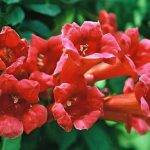 hummingbirds. It thrives best in full, hot sun and produces orange, red, even yellow blooms. The plant is a good erosion control for steep banks, and the blossoms of orange red and yellow make a very attractive ground cover.
hummingbirds. It thrives best in full, hot sun and produces orange, red, even yellow blooms. The plant is a good erosion control for steep banks, and the blossoms of orange red and yellow make a very attractive ground cover.
Columbine – This elegant spring bloomer comes in shades of blue, purple, red, and pink. It thrives in areas with partial shade, where it can grow to 20 inches tall. A perennial, this Arizona native is especially important for migrating birds heading north when few flowers are in bloom.
Bee Balm – The full spikes and spherical shape of bee balm makes it an interesting and 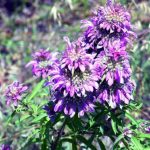 attractive plant for many gardens. Also called bergamot, horsemint, and monarda, this plant thrives best in full sun and will grow 12-36 inches high. Different cultivars are available in bright shades of pink, red, orange, and purple.
attractive plant for many gardens. Also called bergamot, horsemint, and monarda, this plant thrives best in full sun and will grow 12-36 inches high. Different cultivars are available in bright shades of pink, red, orange, and purple.
Cardinal Flower – The red flowers are ideal for attracting hummingbirds. This plant does best in moist, well-drained soil. Its long stalks of flowers can grow as high as 36 inches, adding height and interest to raised flowerbeds. The rich red blooms are delicately shaped and attractive, both for landscaping and for the birds.
Salvia – Anytime you see sage or salvia in a plant name you have a local winner. Tall 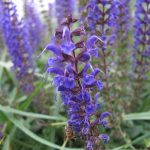 blue spikes of delicate flowers make this a great plant for the back or center of flowerbeds. It often is used as an anchor in wildflower gardens. Related to mint, salvia flowers emerge in mid-summer and keep blooming through fall. Ideal in full sun, it comes back larger each year. Spread easily by seed.
blue spikes of delicate flowers make this a great plant for the back or center of flowerbeds. It often is used as an anchor in wildflower gardens. Related to mint, salvia flowers emerge in mid-summer and keep blooming through fall. Ideal in full sun, it comes back larger each year. Spread easily by seed.
Zinnia – Easy to grow, this annual bloom has a full, compact shape and works best in full sun. It blooms repeatedly from June through autumn, making it an ideal choice for migrating hummingbirds. Blooming here at Watters in shades of pink, red, orange, yellow, white, and multi-colored. The summer-long blooms are Javelina, deer, and rabbit resistant.
Bleeding Heart – Bleeding hearts are locally hardy with few problems, but thrive best in 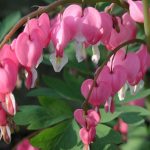 lightly shaded locations. The plants grow knee high and can be divided to transplant as they grow larger, making them an economical choice for hummingbird gardens. The lacy foliage is a perfect background for the stunning spring blooms that are heart-shaped dangles of white or pinks.
lightly shaded locations. The plants grow knee high and can be divided to transplant as they grow larger, making them an economical choice for hummingbird gardens. The lacy foliage is a perfect background for the stunning spring blooms that are heart-shaped dangles of white or pinks.
Lupine – This early blooming flower is ideal for attracting spring hummingbirds before other flowers have emerged. Its blossoms of blue and purple shades are beautiful in spring gardens. It is a drought tolerant plant that works best in areas with full sunlight.
Butterfly Bush – True to its name this plant is attractive to butterflies, but local 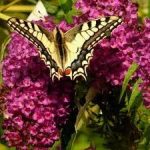 hummingbirds also love this brightly colored bush. The thick elongated clusters of flowers come in pink, white, and purple shades, and will bloom repeatedly from mid-summer through fall. This is a drought tolerant plant that thrives in full sun, developing into a thick, luxurious shrub over time.
hummingbirds also love this brightly colored bush. The thick elongated clusters of flowers come in pink, white, and purple shades, and will bloom repeatedly from mid-summer through fall. This is a drought tolerant plant that thrives in full sun, developing into a thick, luxurious shrub over time.
Petunias are easy to grow and are inexpensive. They thrive best in full sun, whether in flowerbeds, borders, containers, or baskets. Workhorses in any garden, petunias bloom in shades of pink, white, red, purple, blue, and stunning variegated shades. They will bloom repeatedly, providing abundant nectar for hungry hummingbirds.
Tulip Tree – An elegant, eye-catching shade tree that holds its own in the largest yards, it is the only tree that shows off large tulip flowers amongst abundant foliage. In Autumn the foliage turns a beautiful gold color. Hummingbirds love to hang out, rest, and nest in the shade of this large bloomer. We have lost of sizes to choose from, but the $121 specimens are magnificent.

Garden Class – The summer class schedule is out, but one class stands out above the  rest: Safe Pets in the Garden, Pet Heat Stroke, and Garden First Aid. On July 9th local veterinarian Dr. O’Sullivan will teach this class at Watters. The doctor will teach us how to garden safely with our pets through the summer. Gardening classes are held every Saturday at 9:30am, but come early for this class and bring a lawn chair. This one will be packed!
rest: Safe Pets in the Garden, Pet Heat Stroke, and Garden First Aid. On July 9th local veterinarian Dr. O’Sullivan will teach this class at Watters. The doctor will teach us how to garden safely with our pets through the summer. Gardening classes are held every Saturday at 9:30am, but come early for this class and bring a lawn chair. This one will be packed!
Until next week, I’ll see you among the hummingbird plants here at Watters Garden Center.
Ken Lain can be found throughout the week at Watters Garden Center, 1815 W. Iron Springs Rd in Prescott, or contacted through his web site at WattersGardenCenter.com or FB.com/WattersGardenCenter .

